AUDI ALLROAD 2000 Owners Manual
Manufacturer: AUDI, Model Year: 2000, Model line: ALLROAD, Model: AUDI ALLROAD 2000Pages: 306, PDF Size: 9.95 MB
Page 241 of 306
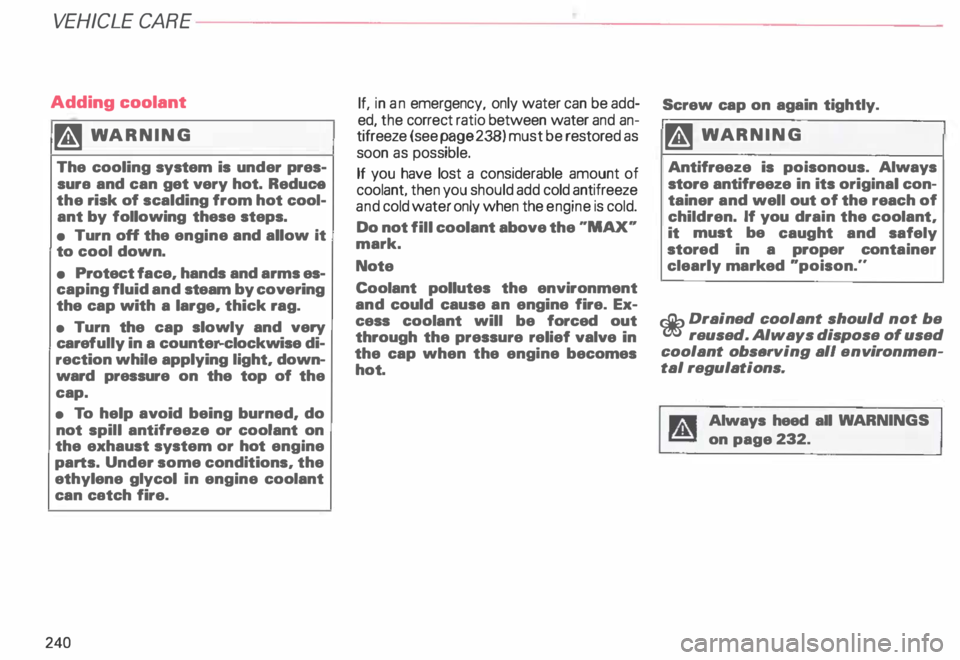
VE
HICLE CARE
Adding coolant
’┐Į WARNING
The cooling system is under pres┬Ł
sura and can get very hot. Reduce
the risk of scalding from hot cool┬Ł
ant by following these steps.
ŌĆó Turn off the engine and allow it
to cool down.
ŌĆó Protect face, hands and arms es┬Ł
caping fluid and steam by covering
the cap with a large, thick rag.
ŌĆó Turn the cap slowly and very
care fully in a counter--clockwise di┬Ł
rection while applying light, down┬Ł
ward pressure on the top of the
cap.
ŌĆó To help avoid being burned, do
not spill antifreeze or coolant on
the exhaust system or hot engine
parts. Under some conditions, the
ethylene glycol in engine coolant
can catch fire.
240 If,
in an emergency, only water can be add┬Ł
ed, the correct ratio between water and an┬Ł
tifreeze (see page 238) must be restored as
soon as possible.
If you have lost a considerable amount of
coolant. then you should add cold antifreeze
and cold water only when the engine is cold.
Do not fill coolant above the "MAX"
mark.
Note
Coolant pollutes the environment
and could cause an engine fire. Ex┬Ł
cess coolant will be forced out
through the pressure relief valve in
the cap when the engine becomes
hot. Screw cap
on again tightly.
’┐Į WARNING
Antifreeze is poisonous. Always
store antifreeze in its original con┬Ł
tainer and well out of the reach of
children. If you drain the coolant,
it must be caught and safely
stored in a proper container
clearly marked "poison ...
<┬Ż> Drained coolant should not be
reused. Always dispose of used
coolant observing all env ironmen┬Ł
tal regulations.
Always heed all WARNINGS
on page 232.
Page 242 of 306
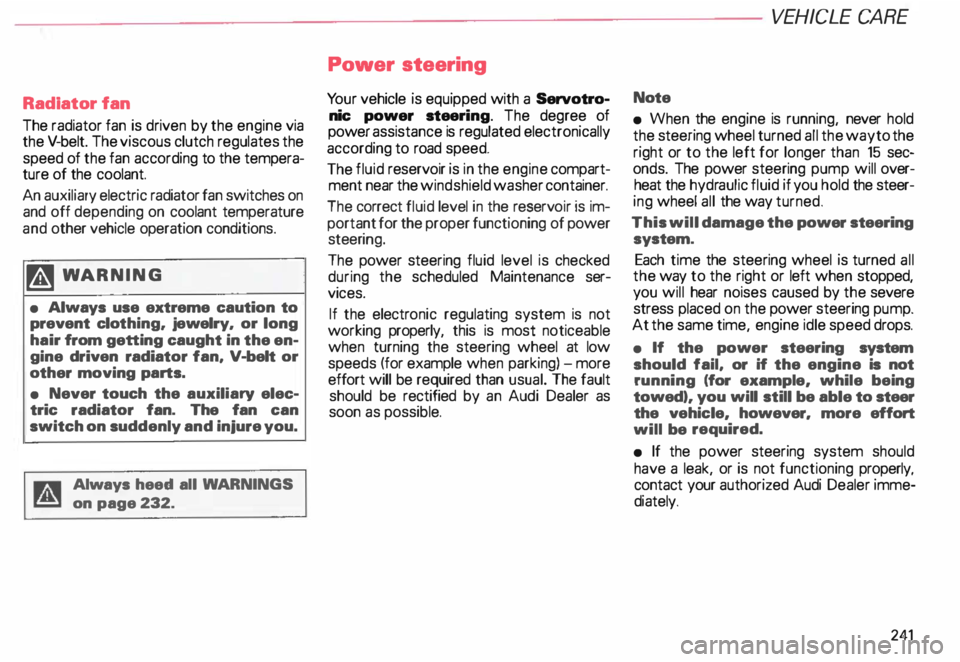
Radiator
fan
The radiator fan is driven by the engine via
the V-belt. The viscous clutch regulates the
speed of the fan according to the tempera┬Ł
ture of the coolant.
An auxiliary electric radiator fan switches on
and off depending on coolant temperature
and other vehicle operation conditions.
’┐Į WARNING
ŌĆó Always use extreme caution to
prevent clothing. jewelry, or long
hair from getting caught in the en┬Ł
gine driven radiator fan, V-belt or
other moving parts.
ŌĆó Never touch the auxiliary elec┬Ł
tric radiator fan. The fan can
switch on suddenly and injure you.
Always heed all WA RNINGS
on page 232. Power
steering
Yo ur vehicle is equipped with a Servotro┬Ł
nic power steering. The degree of
power assistance is regulated electronically
according to road speed.
The fluid reservoir is in the engine compart┬Ł
ment near the windshield washer container.
The correct fluid level in the reserv oir is im┬Ł
portant for the proper functioning of power
steer ing.
The power steering fluid level is checked
during the scheduled Maintenance ser┬Ł
vices.
If the electronic regulating system is not
working properly, this is most noticeable
when turning the steering wheel at low
speeds (for example when parking) -more
effort will be required than usual. The fault
should be rectified by an Audi Dealer as
soon as possible. VEH
ICLE CARE
Note
ŌĆó When the engine is running, never hold
the steering wheel turned all the way to the
right or to the left for longer than 15 sec┬Ł
onds. The power steering pump will over┬Ł
heat the hydraulic fluid if you hold the steer┬Ł
ing wheel all the way turned.
This will damage the power steering
system.
Each time the steering wheel is turned all
the way to the right or left when stopped,
you will hear noises caused by the severe
stress placed on the power steering pump.
At the same time, engine idle speed drops.
ŌĆó If the power steering system
should fail, or if the engine is not
running (for example, while being
towed). you will still be able to steer
the vehicle, however. more effort
will be required.
ŌĆó If the power steering system should
have a leak, or is not functioning properly,
contact your authorized Audi Dealer imme┬Ł
diately.
241
Page 243 of 306
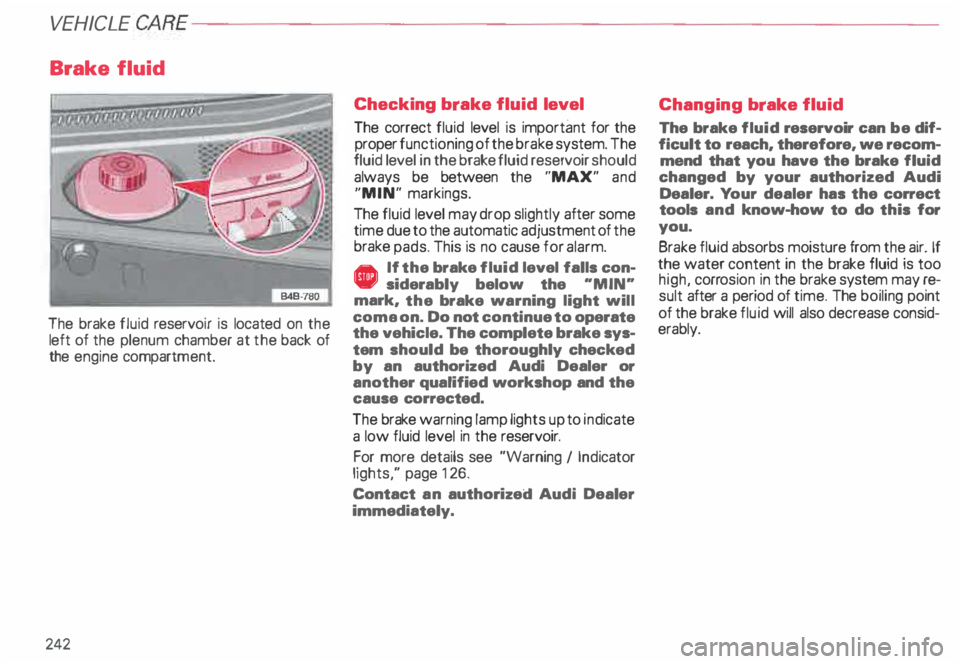
VE
HICLE CA
RE----------------------------------------------------
Brake fluid
The brake fluid reservo ir is located on the
left of the plenum chamber at the back of
the engine compartm ent.
242 Checking
brake fluid level
The correct fluid level is important for the
proper functioning of the brake system. The
fluid level in the brake fluid reservoir should
always be between the "MAX" and
"MIN" markings.
The fluid level may drop slightly after some
time due to the automatic adjustment of the
brake pads. This is no cause for alarm.
ŌĆó If the brake fluid level falls con┬Ł
siderably below the "MIN"
mark, the brake warning light will
coma on. Do not continue to operate
the vehicle. The complete brake sys┬Ł
tem should be thoroughly checked
by an authorized Audi Dealer or
another qualified workshop and the
cause corrected.
The brake warning lamp lights up to indicate
a low fluid level in the reservoir.
For more details see "Warning I Ind icator
lights," page 126.
Contact an authorized Audi Dealer
immediately. Changing
brake fluid
The brake fluid reservoir can be dif┬Ł
ficult to reach, therefore, we recom┬Ł
mend that you have the brake fluid
changed by your authorized Audi
Dealer. Your dealer has the correct
tools and know-how to do this for
you.
Brake fluid absorbs moisture from the air. If
the water content in the brake fluid is too
high, corrosion in the brake system may re┬Ł
sult after a period of time. The boiling point
of the brake fluid will also decrease consid┬Ł
erably.
Page 244 of 306
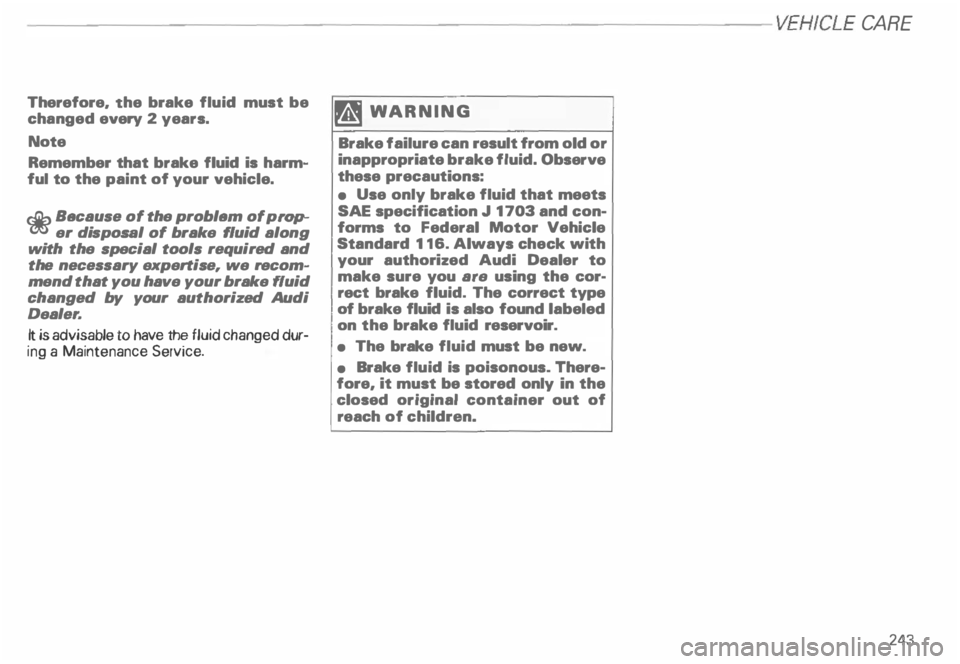
-------------------------VEHICLE CA
RE
Therefore, the brake fluid must be
changed every 2 years.
Note
Remember that brake fluid is harm┬Ł
ful to the paint of your vehicle.
c┬Ż> Because of the problem of pro’┐Į
er disposal of brake fluid along
with the special tools required and
the necessary expertise, we recom┬Ł
mend that you have your brake fluid
changed by your authorized Audi
Dealer.
It is advisable to have the fluid changed dur┬Ł
ing a Maintenance Service. ’┐ĮW
ARNING
Brake failure can result from old or
inappropriate brake fluid. Observe
these precautions:
ŌĆó Use only brake fluid that meets
SAE specification J 17 03 and con┬Ł
forms to Federal Motor Vehicle
Standard 116. Always check with
your authorized Audi Dealer to
make sure you are using the cor┬Ł
rect brake fluid. The correct type
of brake fluid is also found labeled
on the brake fluid reservoir.
ŌĆó The brake fluid must be new.
ŌĆó Brake fluid is poisonous. There┬Ł
fore, it must be stored only in the
closed original container out of
reach of children.
243
Page 245 of 306
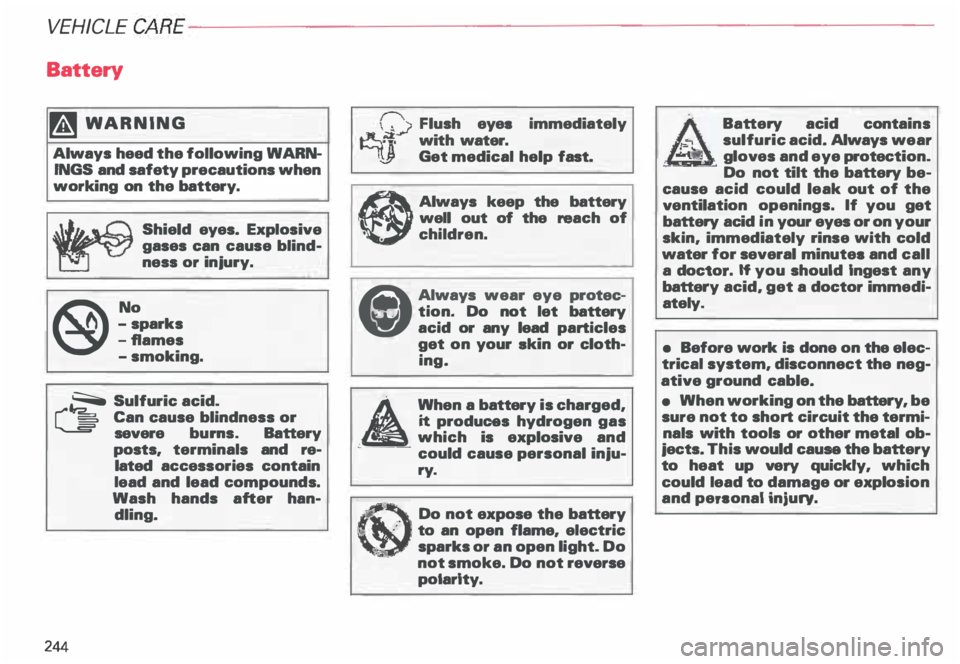
VE
HICLE CA
RE----------------------------------------------------
Battery
’┐ĮW ARNING
Always heed the following WARN┬Ł
INGS and safety precautions when
working on the battery.
Shield eyes. Explosive
gases can cause blind┬Ł
ness or injury.
@ No
-s parks
-f lames
-s moking.
’┐Į Sulfuric acid.
’┐Į Can cause blindness or
severe bums. Battery
posts, terminals and re┬Ł
lated accessories contain
lead and lead compounds.
Wash hands after han┬Ł dling.
244
() Flush eyes immediately
’┐Įi'l with water.
’┐Į Get medical help fast.
@ Always keep the battery
well out of the reach of
children.
f) Always wear eye protec┬Ł
tion. Do not let battery
acid or any lead particles
get on your akin or cloth┬Ł
ing.
A . When a battery is charged,
it
produces hydrogen gas
. which is explosive and
┬Ę
could cause personal inju┬Ł
ry.
® Do not expose the battery
to an open flame, electric
"""' sparks or an open light. Do
not smoke. Do not reverse
polarity.
&┬Ę. Battery acid contains
sulfuric acid. Always wear
gloves and eye protection.
Do not tilt the battery be┬Ł
cause acid could leak out of the
ventilation openings. If you get
battery acid in your eyes or on your
skin, immediately rinse with cold
water for several minutes and call
a doctor. If you should ingest any
battery acid, get a doctor immedi┬Ł
ately.
ŌĆó Before work is done on the elec┬Ł
trical system, disconnect the neg┬Ł
ative ground cable.
ŌĆó When working on the battery, be
sure not to short circuit the termi┬Ł
nals with tools or other metal ob┬Ł
jects. This would cause the battery
to heat up very quickly, which
could lead to damage or expl osion
and personal injury.
Page 246 of 306
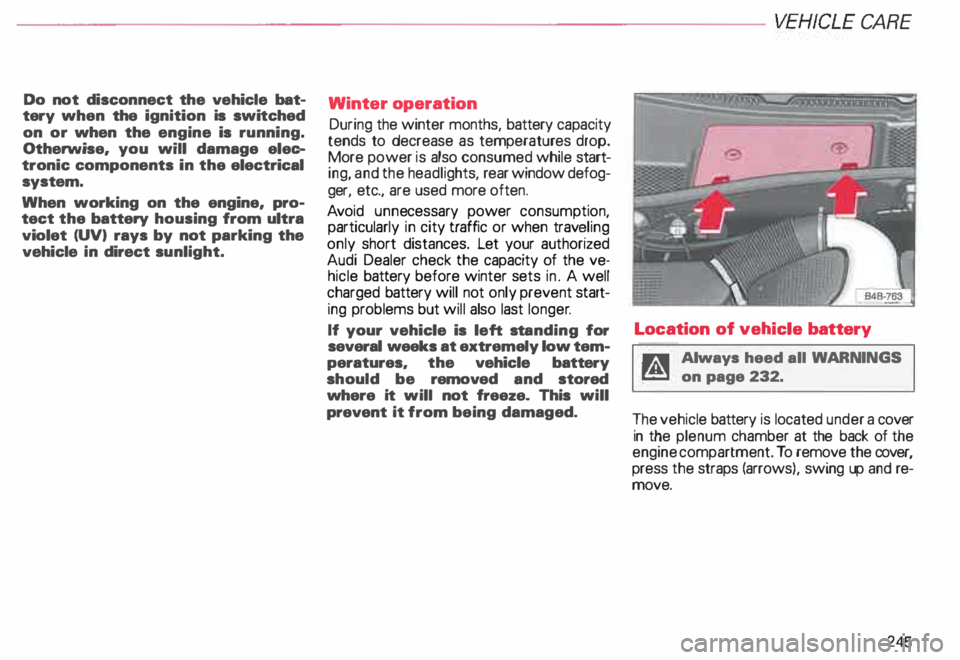
-------------------------VEHICL E CA RE
Do not disconnect the vehicle bat┬Ł
tery when the ignition is switched
on or when the engine is running.
Otherwise, you will damage elec┬Ł
tronic components in the electrical
system.
When working on the engine, pro┬Ł
tect the battery housing from ultra
violet (UV) rays by not parking the
vehicle in direct sunlight. Winter
operation
During the winter months, battery capacity
tends to decrease as temperatures drop.
More power is also consumed while start┬Ł
ing, and the headli ghts, rear window defog┬Ł
ger, etc., are used more often.
Av oid unne cessary power consumption,
particularly in city traffic or when trave:ling
only short distances. Let your authonzed
Audi Dealer check the capacity of the ve┬Ł
hicle battery before winter sets in. A well
charged battery will not only prevent start┬Ł
ing problems but will also last longer.
If your vehicle is left standing for
several weeks at extremely low tem┬Ł
peratures, the vehicle battery
should be removed and stored
where it will not freeze. This will
prevent it from being damaged. Location
of vehicle battery
g Always heed all WAR NINGS
’┐Į on page 232.
The vehicle battery is located under a cover
in the plenum chamber at the back of the
engine compartment. To remove the cover,
press the straps (arrows ), swing up and re┬Ł
move.
245
Page 247 of 306
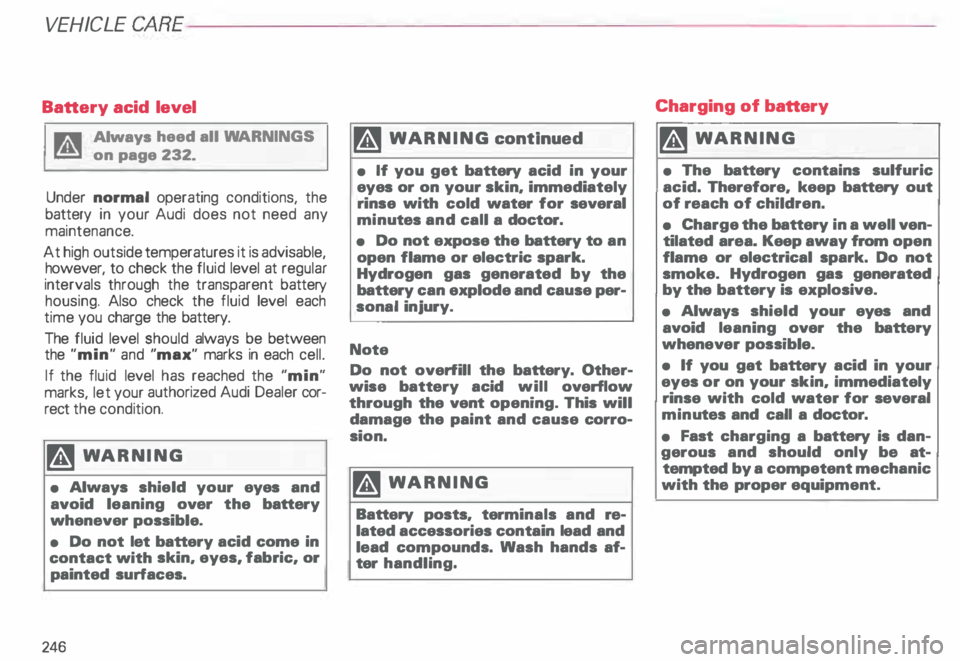
VEHICLE CA
RE---------------------------------------------------
Battery acid level
g Always heed all WA RNINGS
’┐Į on page 232.
Under normal operating conditions, the
battery in your Audi does not need any
maintenance.
At high outside temperatures it is advisable,
however, to check the fluid level at regular
intervals through the transparent battery
housing. Also check the fluid level each
time you charge the battery.
The fluid level should always be between
the "min" and "max" marks in each cell.
If the fluid level has reached the "min"
marks, let your authorized Audi Dealer cor┬Ł
rect the condition.
’┐ĮW ARNIN G
ŌĆó Always shield your eyes and
avoid leaning over the battery
whenever possible.
ŌĆó Do not let battery acid come in
contact with skin, eyes, fabric, or
painted surfaces.
246 ’┐Į’┐Į
WARNING continued
ŌĆó If you get battery acid in your
eyes or on your skin, immediately
rinse with cold water for several
minu tes and call a doctor.
ŌĆó Do not expose the battery to an
open flame or electric spark.
Hydrogen gas generated by the
battery can explode and cause per┬Ł
sonal injury.
Note Do not overfill the battery. Other┬Ł
wise battery acid will overflow
through the vent opening. This will
damage the paint and cause corro┬Ł
sion.
’┐ĮW ARNIN G
Battery posts, terminals and re┬Ł
lated accessories contain lead and
lead compounds. Wash hands af┬Ł
ter handling. Charging
of battery
’┐ĮW ARNING
ŌĆó The battery contains sulfuric
acid. Therefore, keep battery out
of reach of children.
ŌĆó Charge the battery in a well ven┬Ł
tilated area. Keep away from open
flame or electrical spark. Do not
smoke. Hydrogen gas generated
by the battery is explosive.
ŌĆó Always shield your eyes and
avoid leaning over the battery
whenever possible.
ŌĆó If you gat battery acid in your
eyes or on your skin, immediately
rinse with cold water for several
minu tes and call a doctor.
ŌĆó Fast charging a battery is dan┬Ł
gerous and should only be at┬Ł
tempted by a competent mechanic
with the proper equipment.
Page 248 of 306
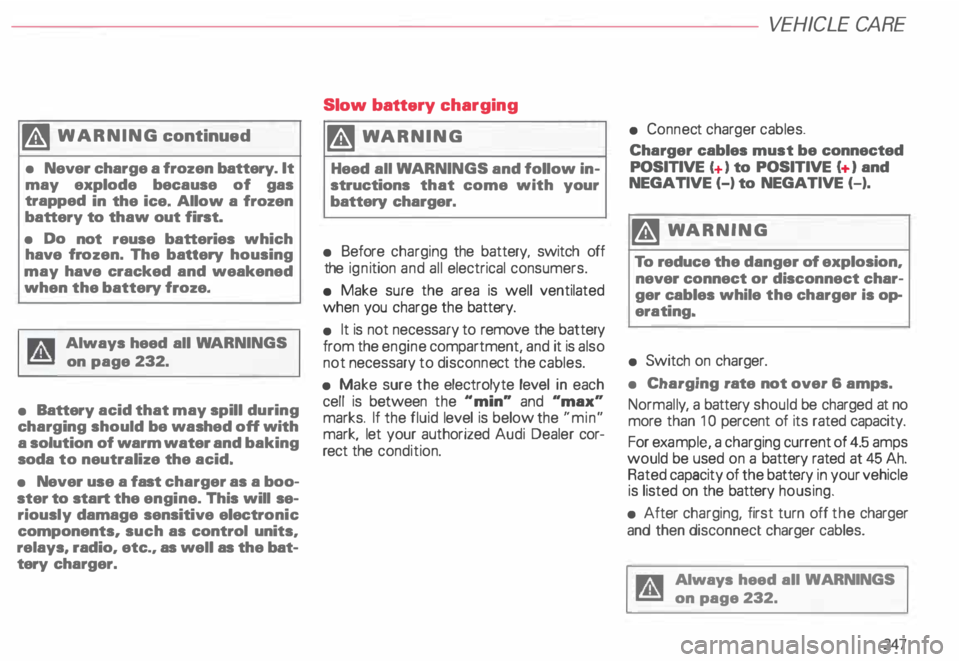
f4 WARNING
continued
ŌĆó Never charge a frozen battery. It
may explode because of gas
trapped in the ice. Allow a frozen
battery to thaw out first.
ŌĆó Do not reuse batteries which
have fr ozen. The baUery housing
may have cracked and weakened
when the battery froze.
Always heed all WA RNINGS
on page 232.
ŌĆó Battery acid that may spill during
charging should be washed off with
a solution of warm water and baking
soda to neutralize the acid.
ŌĆó Never use a fast charger as a boo┬Ł
ster to start the engine. This will se┬Ł
riously damage sensitive electronic
components, such as control units,
relays, radio, etc., as well as the bat┬Ł
tery charger. Slow
battery charging
’┐ĮW ARNING
Heed all WA RNINGS and follow in┬Ł
structions that come with your
battery charger.
ŌĆó Before charging the battery, switch off
the ignition and all electrical consumers.
ŌĆó Make sure the area is well ventilated
when you charge the battery.
ŌĆó It is not necessary to remove the battery
from the engine compartment, and it is also
not necessary to disconn ect the cables.
ŌĆó Make sure the electrolyte level in each
cell is between the .. min" and "max ..
marks. If the fluid level is below the "min"
mark, let your authorized Audi Dealer cor┬Ł
rect the condition. VE
HICLE CARE
ŌĆó Conne ct charger cables.
Charger cables must be connected
POSITIVE (+ ) to POSITIVE (+ ) and
NEGATIVE (-) to NEGATIVE (-).
’┐ĮW ARNING
To reduce the danger of explosion,
never connect or disconnect char┬Ł
ger cables while the charger is op┬Ł
erating.
ŌĆó Switch on charger.
ŌĆó Charging rate not over 6 amps.
Normal ly, a battery should be charged at no
more than 1 0 percent of its rated capacity.
For example, a charging current of 4.5 amps
would be used on a battery rated at 45 Ah.
Rated capacity of the battery in your vehicle
is listed on the battery housing.
ŌĆó After charging, first turn off the charger
and then disconnect charger cables. g Always heed all WARNINGS
’┐Į on page 232.
247
Page 249 of 306

VEHICLE CA
RE----------------------------------------------------
When disconnecting and
connecting the battery ...
When you disconnect the vehicle battery
please note the following:
- some data stored in the driver informa-
tion system are erased,
- the clock goes out,
- the factory installed radio locks up,
- the Engine management system,
- the one-touch-u p and one-touch-down
functions of the power windows no lon┬Ł
ger work,
- all stored seat positions in the memory*
are erased.
Af teryou reconnect the battery, you must
reset the clock. ’┐Į page 118.
You also have to reset the Engine manage┬Ł
ment system -see "Starter Switch "
’┐Įpa ge 113.
You also have to reset the one-touch-up and
one-touch’┐Įdown feature on power win┬Ł
dows -see "Power windows "
’┐Įp age 71.
248 You
have also reset the seat memory* -see
"Seats"
’┐Į page 81.
The radio must be re-coded with the correct
radio code - see your radio Operating In┬Ł
structions.
Replacement battery
A replacement battery must have the same
specifications and dimensions as the origi┬Ł
nal equipment battery. Specifications are
listed on the battery housing.
When installing the battery, make sure the
ignition and all electrical consumers are
switched off.
r.Gb. Because of the problem of ’┐Įproper di
sposal of a battery, we
recommend that you have your au┬Ł
thorized Audi Dealer change the
battery for you. Batteries contain
sulfuric acid and lead and must al┬Ł
ways be disp osed of properly ob┬Ł
serving all environmental regula┬Ł
tions. Air
cleaner
A dir ty air cleaner element not only reduces
the engine output and increases fuel con┬Ł
sumption considerably but can also cause
premature engine wear.
Normally, it is not necessary to service the
air cleaner more often than recommended
in the Maintenance booklet. If the vehicle is
driven on very dusty roads, the air cleaner
must be serviced more frequently, even dai┬Ł
ly.
If your air cleaner element must be
changed mora frequently, we rec┬Ł
ommend that you have the air clean┬Ł
er serviced by your authorized Audi
Dealer or a qualified workshop.
The air cleaner element must never
be cleaned or soaked with gasoline,
cleaning solvents or oil.
g Always heed all WARN INGS
t!!3 on page 232.
Page 250 of 306
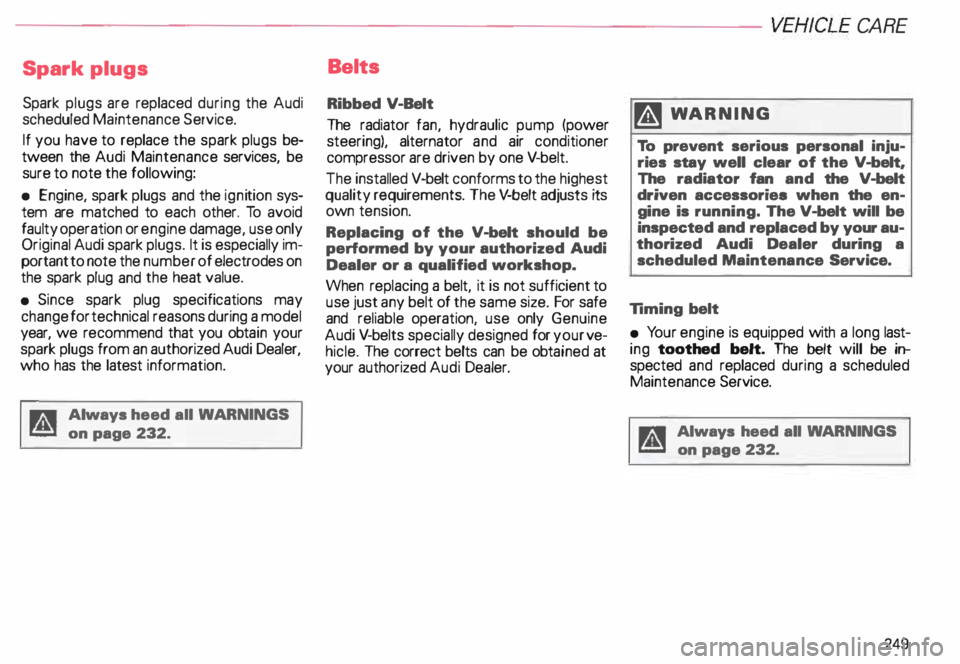
-------------------------VEHICLE
CARE
Spark plugs
Spark plugs are replaced during the Audi
scheduled Maintenance Service.
If you have to replace the spark plugs be┬Ł
tween the Audi Maintenance services, be
sure to note the following:
ŌĆó Engine, spark plugs and the ignition sys┬Ł
tem are matched to each other. To avoid
faulty operation or engine damage, use only
Original Audi spark plugs. It is especially im┬Ł
portant to note the number of electrodes on
the spark plug and the heat value.
ŌĆó Since spark plug specifications may
change for technical reasons during a model
year, we recommend that you obtain your
spark plugs from an authorized Audi Dealer,
who has the latest information.
Always heed all WARNINGS
on page 232. Belts
Ribbed V-Belt
The radiator fan, hydraulic pump (power
steering), alternator and air conditioner
compressor are driven by one V-belt.
The installed V-belt conforms to the highest
quality requirements. The V-belt adjusts its
own tension.
Replacing of the V-belt should be
performed by your authorized Audi
Dealer or a qualified workshop.
When replacing a belt, it is not sufficient to
use just any belt of the same size. For safe
and reliable operation, use only Genuine
Audi V-belts specially designed for your ve┬Ł
hicle. The correct belts can be obta ined at
your authorized Audi Dealer. ’┐ĮW
ARNING
To prevent serious personal inju┬Ł
ries stay well clear of the V-belt,
The radiator fan and the V-belt
driven accessories when the en┬Ł
gine is running. The V-belt will be
inspected and replaced by your au┬Ł
thorized Audi Dealer during a
scheduled Maintenance Service.
Timing belt
ŌĆó Yo ur engine is equipped with a long last┬Ł
ing toothed belt. The belt will be in┬Ł
spected and replaced during a scheduled
Maintenance Service.
Always heed all WA RNINGS
on page 232.
249